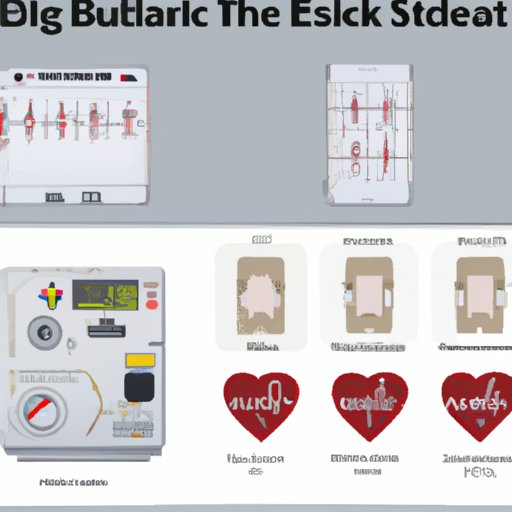Introduction
A defibrillator is a medical device that is used to deliver an electric shock, or defibrillation, to restore a normal heartbeat in individuals who are experiencing sudden cardiac arrest. The purpose of this shock is to stop the irregular heart rhythm and restore a normal heartbeat. A defibrillator is typically used by medical professionals such as doctors, nurses, and paramedics. However, there are also automated external defibrillators (AEDs) which can be used by members of the public with minimal training.
In this article, we will explore how a defibrillator works, the different types of defibrillators available, and the safety features that are incorporated into these devices. We will also provide a step-by-step guide to using a defibrillator and examine the science behind how these life-saving devices work.
Explaining the Functionality of a Defibrillator
A defibrillator is used to deliver an electric shock to the heart in order to restore a normal rhythm when a person is experiencing sudden cardiac arrest. According to the American Heart Association, “Sudden cardiac arrest occurs when the heart’s electrical system malfunctions, causing the heart to suddenly stop beating.” In order to restore a normal rhythm, a defibrillator sends an electric current through the heart, disrupting the chaotic electrical activity and allowing the heart to reset itself.
When used correctly, a defibrillator can be a life-saving device. In fact, the National Institutes of Health reports that “defibrillation within five minutes of collapse can double or triple a person’s chance of survival.”
A Step-By-Step Guide to Using a Defibrillator
Using a defibrillator correctly is essential for ensuring a successful outcome. Here is a step-by-step guide to using a defibrillator:
1. Prepare the equipment: Before using the defibrillator, make sure the unit is turned on and all necessary supplies are readily available. Check the patient for signs of life such as pulse, respiration, and consciousness.
2. Operate the defibrillator: Once the equipment is ready, attach the electrodes to the patient’s chest according to the manufacturer’s instructions. Follow the prompts on the defibrillator to deliver the shock.
3. Monitor the patient: After delivering the shock, monitor the patient for any changes in vital signs. If the patient does not respond, repeat the process according to the manufacturer’s instructions.
Examining the Different Types of Defibrillators
There are two main types of defibrillators: manual and automated. Manual defibrillators require an operator to manually deliver the shock, while automated defibrillators use voice prompts to guide the user through the process. Automated defibrillators are generally easier to use and are recommended for use by untrained personnel.
In addition to manual and automated defibrillators, there are also external and implantable defibrillators. External defibrillators are used in emergency situations and are designed to be used once. Implantable defibrillators are surgically implanted devices that are designed to be used multiple times and are typically used for long-term treatment of certain heart conditions.

The Science Behind How a Defibrillator Works
In order to understand how a defibrillator works, it is important to understand the basics of electricity and how electricity is used to restart the heart. When the heart stops beating, it is because the electrical signals that control the heart’s rhythm have become chaotic and out of sync. The purpose of a defibrillator is to send an electric current through the heart, disrupting the chaotic electrical activity and allowing the heart to reset itself.
According to the American Heart Association, “the electric shock interrupts the abnormal rhythm, allowing the heart’s natural pacemaker to take over.” The electric shock delivered by a defibrillator is powerful enough to stop the chaotic electrical activity and allow the heart to return to its normal rhythm.

An Overview of the Components of a Defibrillator
A defibrillator is made up of several components, including electrical components, battery-related components, and protective components. Electrical components include the electrodes, which deliver the electric shock, and the defibrillator itself. Battery-related components include the battery, which powers the defibrillator, and the charger, which is used to charge the battery. Protective components include an insulation layer, which prevents the electric shock from being transmitted to other parts of the body, and an automatic shutoff feature, which prevents the electric shock from being delivered if the patient does not need it.

Understanding the Safety Features of a Defibrillator
Defibrillators are designed with several safety features to ensure the safety of both the patient and the operator. These safety features include automatic shutoff features which prevent the electric shock from being delivered if the patient does not need it, as well as emergency protocols which guide the operator through the process of delivering the electric shock.
In addition, many defibrillators are equipped with audio and visual alarms which alert the operator if the device is not functioning properly. These features are designed to help prevent accidents and ensure the safety of both the patient and the operator.
Conclusion
A defibrillator is a medical device that is used to deliver an electric shock to the heart in order to restore a normal rhythm when a person is experiencing sudden cardiac arrest. Defibrillators can be either manual or automated and come in both external and implantable models. They are designed with several safety features to ensure the safety of both the patient and the operator. By understanding how a defibrillator works and the different types available, we can ensure that these life-saving devices are used correctly and safely.
(Note: Is this article not meeting your expectations? Do you have knowledge or insights to share? Unlock new opportunities and expand your reach by joining our authors team. Click Registration to join us and share your expertise with our readers.)
